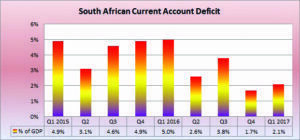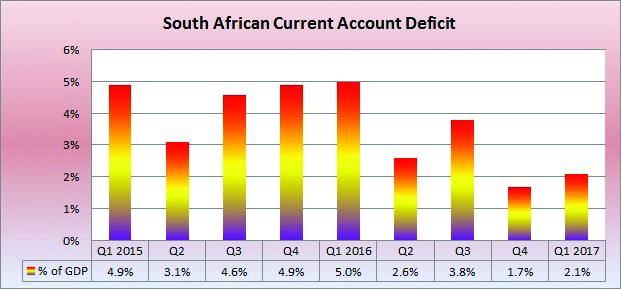By Helmo Preuss
The South African current account deficit on the balance of payments widened to 2.1% of gross domestic product (GDP) on a seasonally adjusted annualised basis in the first quarter 2017. It rose from 1.7% in the fourth quarter 2016, the South African Reserve Bank (SARB) said in its latest Quarterly Bulletin.

The rand has weakened considerably over the past few years versus the US dollar as
a current account deficit above 3% is seen as unsustainable, reaching a
record worst level in January 2016 before recovering during the course of 2016 as
the current account narrowed. The consensus forecast of economists was for a slight
widening in the current account deficit to 2.3% of GDP in the first
quarter.
On an annual basis, the current account deficit narrowed to 3.3% of GDP in
2016 from 4.4% in 2015, 5.35 in 2014 and 5.9% in 2013. It
was only 1.5% in 2010. A current account deficit implies that the country’s
domestic production is unable to keep pace with domestic demand, so South Africa’s
real GDP growth rate, as measured from the production side, has slipped from 3.3% in 2011 to 2.2% in 2013, 2.5% in 2012, 1.7% in 2014, 1.3% in 2015 and 0.3% in 2016.
South Africa, as a small open economy, has a large exposure to its foreign trade
sector with exports of goods and services accounting for 30.3% of GDP in
2016, while imports have a 30.2% share of GDP. In the recession year of
2009, exports only accounted for 27.9% of GDP, while imports had a 27.5% share.
In the first quarter 2017 the import penetration ratio rose to 26.1% from
25.7% in the fourth quarter, but remained well below the levels reached in
2015 when the current account deficit was 4.4% of GDP.




